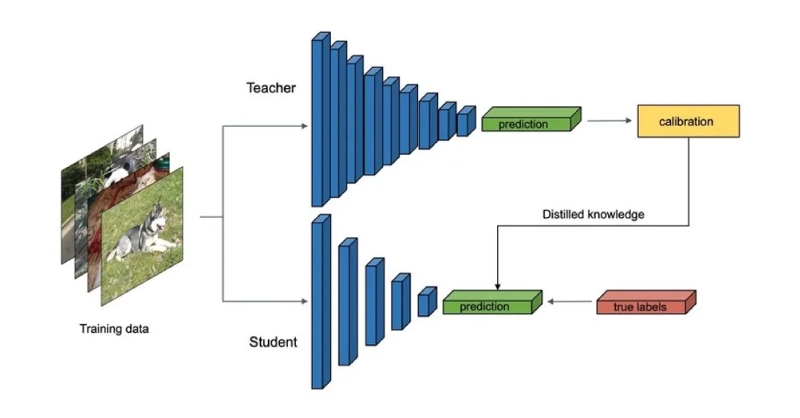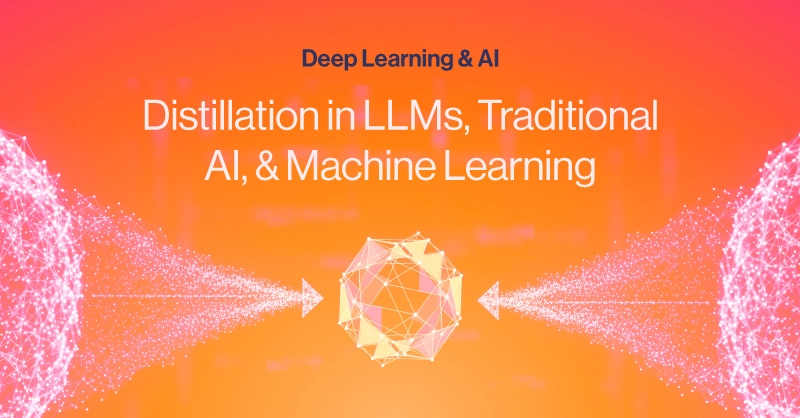Introduction
With models increasing in complexity and size, deploying them requires significant computing resources to run them. This makes deploying AI expensive. Model distillation solves this by creating smaller, faster models that retain most of the performance of the larger counterpart. Key word: mostly.
What is Model Distillation & How does Distillation Work?
Model Distillation is a compression technique where a large trained deep learning AI model transfers its knowledge to a smaller AI model. This relationship between the larger model and the smaller model is referred to as a teacher and student. The goal of model distillation is to maintain high and acceptable accuracy while reducing size and inference computing costs.
- The teacher model generates soft labels—probability distributions over classes—rather than hard labels.
- The student model is trained to mimic these soft outputs using temperature scaling to make the teacher’s predictions smoother and more informative.
- Additional steps, such as fine-tuning, help the student model approach the teacher’s accuracy while requiring fewer resources.
This approach enables developers to deploy AI models on devices with limited compute power without compromising performance too much. Model distillation offers several practical benefits and one downside:
- Faster Inference & Low Latency: Smaller models respond quicker, crucial for real-time applications.
- Reduced Deployment Costs: Lower compute requirements cut cloud expenses and make edge deployment feasible.
- Energy Efficiency: Less computation means lower power consumption—ideal for mobile and IoT.
- Less Consistent Accuracy: Because the model has lost a majority of its parameters, distilled models cannot generalize as well, thus, prone to hallucinations.

Types of Model Distillation
Model distillation isn’t a one-size-fits-all approach. Different methods transfer knowledge in different ways:
- Logit Distillation
- The most common approach. The student model learns from the teacher’s soft logits (probability outputs) instead of hard labels. Helps capture richer information, like class similarities.
- Feature Distillation
- Instead of just outputs, the student mimics intermediate feature representations from the teacher.
- Useful for deep architectures like CNNs, where feature maps contain critical spatial and semantic information.
- Relation-Based Distillation
- Goes beyond individual features and logits.
- Transfers relationships between data points or features (e.g., attention patterns in transformers).
- Often used in complex architectures like LLMs.
Distillation for LLMs
Large Language Models (LLMs) like GPT or BERT can have billions of parameters, making them expensive to deploy. Distillation helps by producing smaller, faster versions that retain most of the original model’s capabilities.
- Benefits for LLMs:
- Reduced Memory Footprint: Essential for edge deployment or cost-sensitive cloud environments.
- Faster Response Times: Enables real-time chatbots, virtual assistants, and enterprise AI applications.
- Lower Hardware Requirements: Distilled LLMs require fewer GPUs for inference, cutting infrastructure costs significantly.
- Example: DeepSeek R1 Distill Qwen 7B is a Qwen 7B model distilled from a DeepSeek R1 model, resulting in a smaller 7 billion parameter model that can run on commodity hardware.
- Hardware Connection:
- Training and distilling LLMs demand HPC servers with multiple GPUs, high memory bandwidth, and fast interconnects like NVLink.
- Companies deploying distilled LLMs can leverage smaller HPC systems for inference, reducing TCO (Total Cost of Ownership). They can also consider client side hardware usage (as opposed to server side computations).
- Our configurable multi-GPU servers enable both teacher model training and student model deployment in optimized environments.
Distillation in Traditional ML vs. Modern AI
While distillation is mainly tied to LLMs and reducing model size, this can also be applied to smaller, less complex models to run on even more constrained compute environments.
- Traditional Machine Learning
- Early use of distillation focused on compressing smaller neural networks for mobile or embedded systems.
- Use cases: Image classification on smartphones, speech recognition in low-power devices.
- Modern AI & Deep Learning
- Distillation now applies to massive models like CNNs, RNNs, and transformers.
- Compressing these models reduces the need for high-end multi-GPU servers during inference, making deployment more cost-efficient.
- Why It Matters for HPC Systems
- Training a teacher model still requires GPU-accelerated infrastructure with powerful hardware like NVIDIA H100 or A100 GPUs.
- Student models, once distilled, can run on smaller HPC nodes or even edge devices with limited compute.
- This balance between high-performance training and efficient deployment highlights the need for configurable HPC systems that scale from multi-GPU training to resource-optimized inference.
7. Challenges & Limitations
While model distillation offers major advantages, it’s not without trade-offs:
- Accuracy Drop
- Student models rarely match the teacher model’s full accuracy.
- This gap can impact mission-critical applications like healthcare or finance.
- Training Complexity
- The process requires an additional training phase, which means extra compute and time—often still demanding multi-GPU HPC systems.
- Specialized Models Lose More
- Models fine-tuned for niche tasks (e.g., scientific simulations, medical NLP) tend to lose performance after distillation because nuanced knowledge doesn’t compress well.
- Not a Substitute for Hardware
- While distillation reduces inference costs, training large models still requires high-end GPU servers. Distillation is an optimization—not a replacement for compute.
FAQ
Are there different types of model distillation for AI?
The three main types are:
- Logit Distillation (matching teacher’s output probabilities)
- Feature Distillation (mimicking internal feature representations)
- Relation-Based Distillation (transferring structural relationships between features).
How does model distillation help with Large Language Models (LLMs)?
You may be familiar with Qwen 2.5 Distill and DeepSeek R1 Distill options for local LLMs. It creates smaller versions of large models like GPT or BERT, reducing memory footprint, speeding up responses, and lowering GPU requirements for inference.
Pros and Cons of Distillation
- Pros of Model Distillation
- Smaller model size → easier deployment.Faster inference and lower latency.Reduced hardware and cloud costs.Lower power consumption for edge devices.Enables AI on resource-constrained environments.
- Cons of Model Distillation
- Accuracy loss compared to the teacher model.
- An additional training step adds complexity and cost.
- May not preserve specialized domain knowledge.
- Still requires powerful hardware for teacher model training.
- Limited effectiveness for extremely large or complex models.
Does model distillation eliminate the need for GPUs and better hardware?
No. Training the original teacher model and performing distillation still require high-performance GPU servers. Distillation mainly optimizes inference costs for running models on lower-power hardware such as client hardware or edge devices.
TLDR & Conclusions
Model distillation is a powerful technique that bridges the gap between large, high-performing AI models and real-world deployment needs. By transferring knowledge from a teacher model to a smaller student model, businesses can achieve faster inference, lower costs, and efficient deployment without completely sacrificing accuracy.
TL;DR – Key Takeaways:
- Distillation compresses large models into smaller, efficient versions.
- Reduces inference time and hardware costs.
- Ideal for cloud, edge, and on-device AI deployment.
- Still needs powerful GPUs for training the teacher model.
- Accuracy trade-offs exist, especially for specialized models.
While Distillation is not the answer and still requires robust hardware for training, its role in scaling AI and LLMs for practical applications onto lower-end hardware has made models more and more accessible.
If you are deploying an AI application onto edge and hardware, distillation is a valuable consideration. Contact SabrePC for more information on evolving your computing infrastructure.



